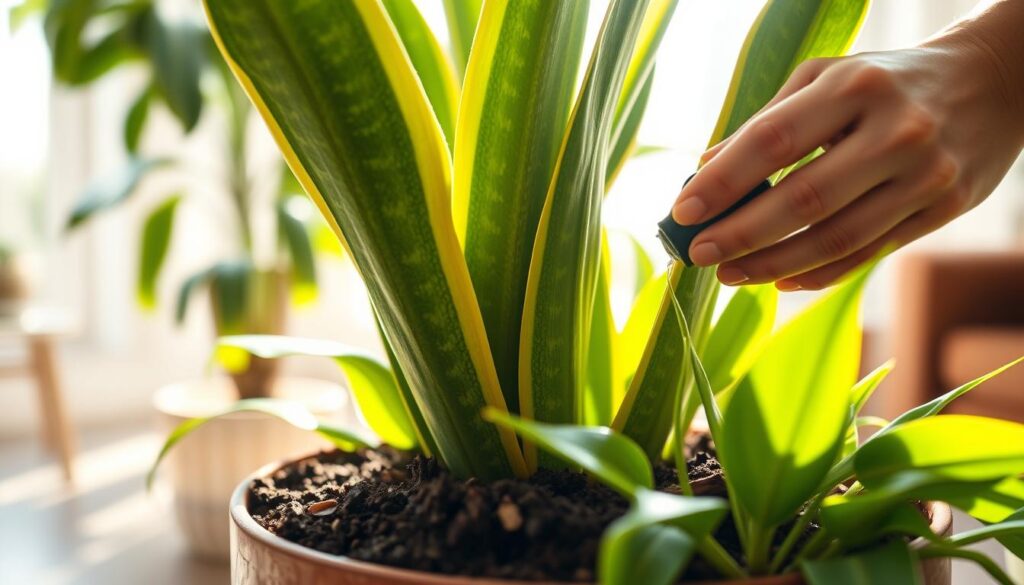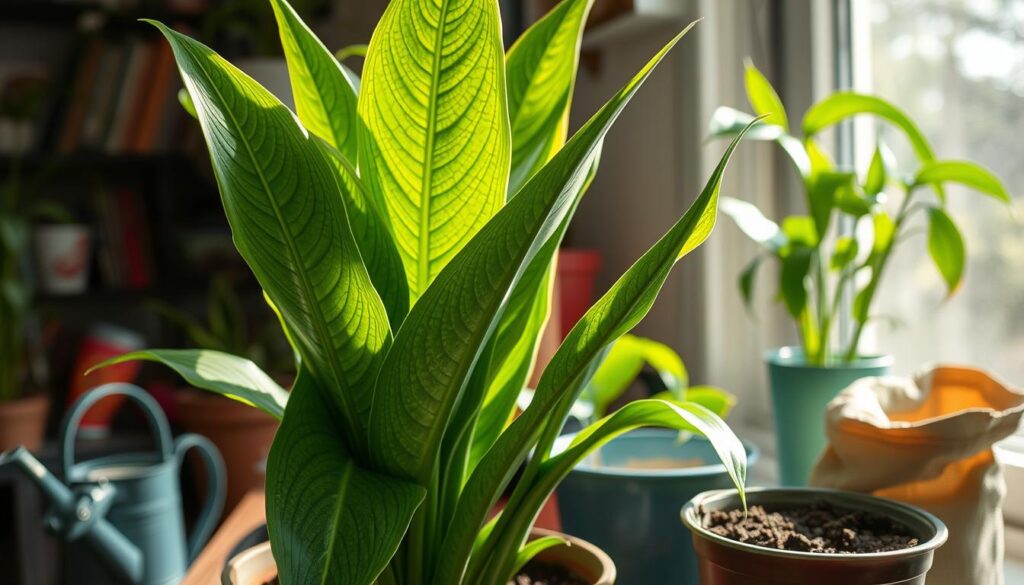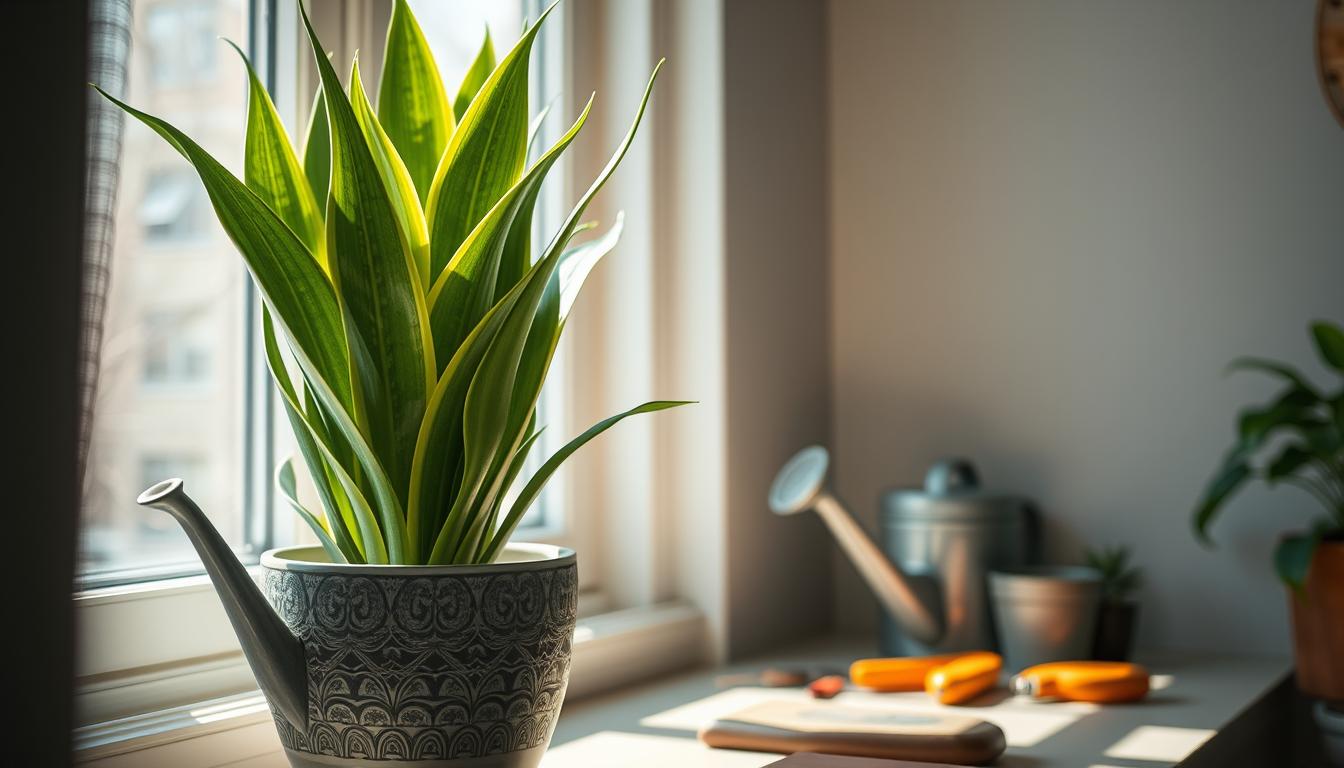Starting with houseplants? You might want something easy to care for. Snake Plants are great because they need little care and can grow in many light conditions. They also clean the air and look nice in your home.
There are over 70 kinds of Snake Plants, each special in its own way. NASA says they clean the air well. This guide will teach you how to care for your Snake Plant. You’ll learn about watering, feeding, trimming, and growing new plants.
We’ll talk about the basics of Snake Plant care. You’ll learn about the right soil, pot, and place for your plant. We’ll also cover different types of Snake Plants and how to spot a healthy one. By the end, you’ll know how to take great care of your Snake Plant. It will grow well with little effort, perfect for indoor care.
Why Choose a Snake Plant for Your Home?
Looking for a houseplant that’s easy to care for? The Snake Plant is a great pick. It’s beautiful and simple to take care of. It’s perfect for busy people or those new to plants.
Snake Plants clean the air, removing bad stuff. This makes your home healthier. They’re great for indoor spaces where air can be bad.
The Perfect Low-Maintenance Greenery
The Snake Plant needs little care. Water it once every two weeks in summer and once every six weeks in winter. It also needs the right light. This way, your plant will grow well and look great.
Air Purification Benefits
Snake Plants also clean the air well. They remove up to 87% of bad stuff at night. This is good for bedrooms, helping you sleep better.
Having a Snake Plant can make your air cleaner. This can help you sleep better and feel calmer. It can even make you more focused and productive.
Understanding Your Snake Plant
Exploring Snake Plant care means learning about different types. There are over 70 species, each with its own look and growth. Knowing what a healthy Snake Plant looks like is key.
Some Snake Plants love dark places, while others need more light. Knowing this helps you care for them better. For more tips, check out trusted houseplant guides.
Different Varieties to Consider
Popular types include the Sansevieria Trifasciata and Sansevieria Zeylanica. Each has special leaves and grows in its own way. Knowing these differences helps you care for your plant better.
Recognizing Healthy Snake Plants
A healthy Snake Plant has strong, green leaves. To keep it this way, give it good soil, indirect light, and the right water. Proper watering is key to avoid root rot.
Common Growth Habits
Snake Plants grow slowly, making them easy to care for. They can handle different light levels and don’t need much water. Knowing these habits helps keep your plant happy and healthy.
| Snake Plant Variety | Growth Habit | Lighting Preference |
|---|---|---|
| Sansevieria Trifasciata | Upright, slow-growing | Low to bright light |
| Sansevieria Zeylanica | Upright, slow-growing | Low to bright light |
Ideal Location for Your Snake Plant
Choosing the right spot for your Snake Plant is key. You want it to grow well. Think about the light it needs. Snake Plants do well in many light conditions.
Here’s what to consider for the best spot:
- Lighting: They like bright, indirect light but can handle low light too. Avoid too much direct sunlight.
- Temperature: They prefer 65-75°F (18-24°C), which is common in homes.
- Humidity: They like a bit drier air than average.
Keep these points in mind to find the best spot. This way, your Snake Plant will thrive. With the right spot, you’ll be a great Snake Plant parent.
| Lighting Condition | Snake Plant Growth |
|---|---|
| Bright Light | Fast growth, enhanced leaf marbling |
| Low Light | Slower growth, smaller leaves |
Watering Your Snake Plant
Watering your Snake Plant is very important. You need to make sure it gets the right amount of water. Too much water can hurt your plant.
Check the soil before you water. This helps avoid too much water. Water your Snake Plant every two weeks. Let the soil dry out first.
This rule might change with the seasons. In winter, water it once a month if the soil is still moist.
Signs of Overwatering and Underwatering
Know the signs of too much or too little water. Overwatered plants have soft, yellow leaves. Underwatered plants have dry, curled leaves.
Use warm water and avoid getting it on the leaves. Water for 10-15 minutes. Use soil that drains fast to avoid waterlogging.
Seasonal Adjustments in Watering
Change your watering as the seasons change. In spring and summer, water every two weeks. In fall and winter, water once a month.
| Season | Watering Frequency |
|---|---|
| Spring/Summer | Every 2 weeks |
| Fall/Winter | Once a month |
Follow these tips to keep your Snake Plant healthy. Adjust your watering based on the season.
Soil and Potting Tips
Choosing the right soil and potting mix is key for Snake Plant care. A good mix drains well and includes perlite, coco coir, and sand. This keeps the soil from getting too wet and protects the roots.
A good Snake Plant soil mix holds moisture but drains extra water. You can mix cactus soil with perlite or sand. Or, use a ready-made succulent soil. Make sure your pot has drainage holes to keep water out of the soil.
For more tips on Snake Plant care, visit trusted houseplant guides. Using the right soil and potting mix will help you care for your Snake Plant well.
Selecting the Best Soil Mix
A good Snake Plant soil mix should:
- Drain well to avoid waterlogged soil
- Keep moisture but drain extra water
- Include perlite, coco coir, and sand for best drainage
Choosing the Right Pot for Your Snake Plant
When picking a pot for your Snake Plant, think about:
- Pot size: should be only 1-2 inches bigger than the root ball
- Drainage holes: very important to keep water out of the soil
- Material: can be plastic, ceramic, or terracotta, as long as it has holes
Fertilizing Your Snake Plant
As you keep your Snake Plant happy, think about fertilizing it. Fertilization gives your plant the nutrients it needs. It’s important to find the right balance to avoid too much fertilizer.
Fertilize your Snake Plant in the spring and summer. Use a balanced fertilizer with a 10-10-10 NPK ratio. Fertilize twice during these seasons to help your plant grow.
When and How to Fertilize
How often you fertilize depends on the light your plant gets. If it’s in bright light, fertilize every 3 months. For medium light, do it twice a year. For low light, once a year. Too much fertilizer can harm your plant.
Best Types of Fertilizers to Use
Choose a balanced, water-soluble fertilizer for your Snake Plant. Fertilizers like Schultz 10-15-10 Plant Food Fertilizer work well. Always follow the package instructions to give your plant the right amount of nutrients.

Signs Your Plant Needs More Nutrients
If your Snake Plant is slow-growing or has yellow leaves, it might need more nutrients. Adjust your fertilizing schedule based on light and fertilizer type. This will help your plant thrive and look beautiful.
| Light Conditions | Fertilization Frequency |
|---|---|
| High Light | Every 3 months |
| Medium Light | Twice a year |
| Low Light | Once a year |
Pruning and Maintenance
Keeping your Snake Plant healthy means regular care. You need to check for dead or damaged leaves. Removing them is key to keeping your plant looking good and stopping disease.
For pruning, use sharp, clean tools. Prune your Snake Plant every 1-2 years. This helps it grow well and look good. Remove dead leaves and cut back long stems to encourage new growth.
Snake Plant care is easy. But, you must dust and water it often. This keeps it happy and healthy.
Here are some tips for pruning and maintaining your Snake Plant:
- Prune your Snake Plant during the active growing season, which is typically in the spring or early summer.
- Remove any dead or damaged leaves to prevent the spread of disease and maintain the plant’s appearance.
- Use sharp and clean tools to minimize the risk of infection.
- Dust your Snake Plant regularly to keep it clean and healthy.
Follow these tips and your Snake Plant will be beautiful and clean air for years. Stay on top of maintenance, and your plant will do great.
| Pruning Frequency | Best Time to Prune | Tools to Use |
|---|---|---|
| Every 1-2 years | Spring or early summer | Sharp and clean tools |
Repotting Your Snake Plant
Repotting is key to keeping your Snake Plant happy. You should do it every 4 to 6 years. Or when the plant is too tight in its pot. Pick a pot that’s just a bit bigger, with holes for water to drain.
Choose a pot with 2 inches of space around your plant. Healthy roots are big and white. Spring is the best time to repot, after it wakes up from winter.
Here are some tips for Snake Plant repotting:
- Use a well-draining soil mix, such as a combination of potting soil and succulent & cactus mix.
- Leave about 1 inch of space between the top of the soil and the pot rim for mess-free watering.
- Avoid watering your snake plant for 5 to 7 days after repotting to allow its roots to acclimate to the new soil mix.
By following these tips, your Snake Plant will stay healthy. Keep an eye on how it grows. Adjust your care routine as needed.
| Repotting Interval | Pot Size | Soil Mix |
|---|---|---|
| Every 4 to 6 years | One size larger than current pot | 2/3 potting soil, 1/3 succulent & cactus mix |
Troubleshooting Common Issues
Even with good Snake Plant care, you might still face pests and diseases. Spotting these problems early helps avoid big damage to your plant.
Common Snake Plant pests are mealybugs and spider mites. Use insecticidal soap or neem oil to fight them. Snake Plant diseases like root rot come from too much water. Cut off bad roots and put the plant in new soil.
To fix common problems, think about these steps:
- Look for Snake Plant pests often and treat them fast if you see them.
- Watch how much water you give your plant to avoid Snake Plant diseases like root rot.
- Give your plant the right Snake Plant care. This means good light, temperature, and humidity to keep it healthy.
By following these tips, you can keep your Snake Plant happy and healthy. Always learn what your plant needs for the best care.

| Common Issue | Cause | Solution |
|---|---|---|
| Yellow leaves | Overwatering | Adjust watering schedule, repot in fresh soil if necessary |
| Brown tips | Improper watering or environmental stressors | Adjust watering schedule, provide proper humidity and temperature |
| Soft, mushy leaves | Overwatering, root rot | Discard affected roots, repot in fresh soil, adjust watering schedule |
Propagating Your Snake Plant
As you learn more about Snake Plant care, you might want to try Snake Plant propagation. This lets you share plants with friends or grow more. It’s a fun way to enjoy these easy-to-care-for plants.
There are a few ways to Snake Plant propagation. You can use water, soil, or division. Each method has its own benefits and challenges. The right choice depends on what you want and what you have.
Different Methods of Propagation
- Water propagation: This method involves placing Snake Plant leaf cuttings in water. Roots grow before moving to soil.
- Soil propagation: Cut leaf sections and plant them in soil. This is another way to go.
- Division propagation: Divide a mature plant’s rhizome to make new ones.
Step-by-Step Guide for Leaf Cuttings
To start, pick healthy, mature leaves. Cut them into sections. Let each section dry for a few days before planting in soil or water. This slow method lets you see roots grow.
Timing and Care for New Plants
New plants need the right care to grow. They need good light, water, and food. Spring and early summer are the best times for Snake Plant care and growing.
Creating a Unique Display with Your Snake Plant
Snake Plant care is fun because you can show off your plant’s beauty. Its striking leaves and growth habits make it perfect for a stunning display. This adds greenery to your space.
Think about the pot and planter for your Snake Plant. You can pick from ceramic, bamboo, or terrarium displays. This choice should match your plant and home style. Adding white pebbles or other plants like Croton can make your space look even better.
Stylish Pot and Planter Choices
- Ceramic pots for a classic look
- Bamboo planters for a natural, earthy feel
- Terrarium displays for a unique, self-sustaining ecosystem
Combining Snake Plants with Other Decor
Pairing your Snake Plant with other plants or decor makes a unique display. Adding a small fern or rosemary can make your space feel lush and inviting.
Seasonal Placement Ideas
Change your Snake Plant decor with the seasons. Move it to a brighter spot in summer. Add festive decorations like pinecones or holly in winter.
Inspiring Ideas for Snake Plant Care
As you care for your Snake Plant, finding inspiration is key. Join online communities to learn from others. You’ll find lots of tips and stories to help you.
Share your Snake Plant journey online. Post about your plant’s growth and your successes and challenges. This way, you’ll connect with others who love Snake Plants as much as you do.
Caring for a Snake Plant is rewarding. It’s not just about the plant’s beauty. It’s also about the pride you feel when it thrives. So, keep trying new things and enjoy your plant’s unique personality. Soon, your home will be a green oasis.
Why stop here? Explore more expert plant care guides, recommendations, and tips at TheTrustedHouseplant.com.





Pingback: 10 Best Air-Purifying Houseplants for a Healthier Home - Trusted House Plant Guide
Pingback: The Ultimate Guide to Houseplants: 100 Best Indoor Plants for Every Home - Trusted House Plant Guide